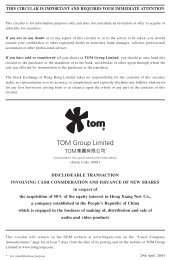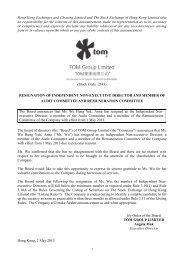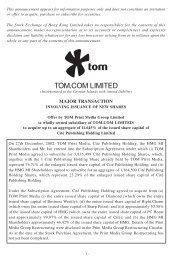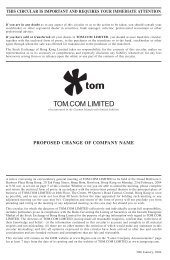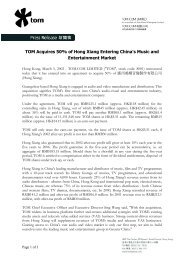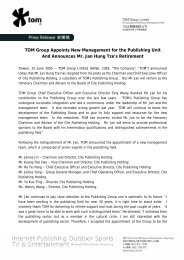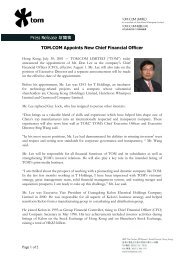2011 Annual Report - TOM Group
2011 Annual Report - TOM Group
2011 Annual Report - TOM Group
You also want an ePaper? Increase the reach of your titles
YUMPU automatically turns print PDFs into web optimized ePapers that Google loves.
54<br />
NOTES TO THE CONSOLIDATED FINANCIAL STATEMENTS<br />
1 Principal accounting policies (Continued)<br />
(b)<br />
Consolidation (Continued)<br />
Any contingent consideration to be transferred by the <strong>Group</strong> is recognised at fair value at<br />
the acquisition date. Subsequent changes to the fair value of the contingent consideration<br />
that is deemed to be an asset or liability is recognised in accordance with HKAS 39 either in<br />
profit or loss or as a change to other comprehensive income. Contingent consideration that is<br />
classified as equity is not remeasured, and its subsequent settlement is accounted for within<br />
equity.<br />
Goodwill is initially measured as the excess of the aggregate of the consideration transferred<br />
and the fair value of non-controlling interest over the net identifiable assets acquired and<br />
liabilities assumed. If this consideration is lower than the fair value of the net assets of the<br />
subsidiary acquired, the difference is recognised in profit or loss.<br />
Inter-company transactions, balances, income and expenses on transactions between group<br />
companies are eliminated. Profits and losses resulting from inter-company transactions that<br />
are recognised in assets are also eliminated. Accounting policies of subsidiaries have been<br />
changed where necessary to ensure consistency with the policies adopted by the <strong>Group</strong>.<br />
In the Company’s statement of financial position, investments in subsidiaries are accounted<br />
for at cost less impairment (note 1(i)). The results of subsidiaries are accounted for by the<br />
Company on the basis of dividends received and receivable.<br />
(c)<br />
Transactions with non-controlling interests<br />
Transactions with non-controlling interests that do not result in loss of control are accounted<br />
for as equity transactions – that is, as transactions with the owners in their capacity as owners.<br />
The difference between fair value of any consideration paid and the relevant share acquired<br />
of the carrying value of net assets of the subsidiary is recorded in equity. Gains or losses on<br />
disposals to non-controlling interests are also recorded in equity.<br />
When the <strong>Group</strong> ceases to have control, any retained interest in the entity is re-measured to<br />
its fair value at the date when control is lost, with the change in carrying amount recognised<br />
in profit or loss. The fair value is the initial carrying amount for the purposes of subsequently<br />
accounting for the retained interest as an associate, joint venture or financial asset. In<br />
addition, any amounts previously recognised in other comprehensive income in respect of<br />
that entity are accounted for as if the <strong>Group</strong> had directly disposed of the related assets or<br />
liabilities. The amounts previously recognised in other comprehensive income are reclassified<br />
to profit or loss.<br />
<strong>TOM</strong> <strong>Group</strong> Limited




